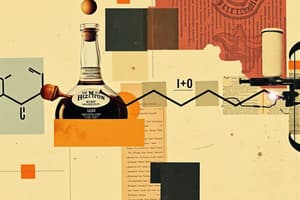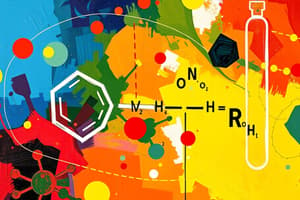Podcast
Questions and Answers
What type of mechanism do reactions with 1° alcohols typically undergo when treated with H-X?
What type of mechanism do reactions with 1° alcohols typically undergo when treated with H-X?
- E2 mechanism
- SN1 mechanism
- SN2 mechanism (correct)
- E1 mechanism
Which reagent is known for oxidizing 2° alcohols into ketones?
Which reagent is known for oxidizing 2° alcohols into ketones?
- H2SO4
- Chromium reagents (correct)
- PCC (correct)
- Swern oxidation (correct)
In the Williamson Ether Synthesis, what reaction mechanism is expected for an ether containing a tertiary carbon?
In the Williamson Ether Synthesis, what reaction mechanism is expected for an ether containing a tertiary carbon?
- SN2 mechanism
- E2 mechanism
- SN1 mechanism (correct)
- Radical mechanism
What is the expected effect of acid-catalyzed ring opening of epoxides?
What is the expected effect of acid-catalyzed ring opening of epoxides?
Which of the following accurately describes the dehydration of 3° alcohols when treated with H2SO4?
Which of the following accurately describes the dehydration of 3° alcohols when treated with H2SO4?
What is the expected outcome when 1° alcohols undergo dehydration with H2SO4?
What is the expected outcome when 1° alcohols undergo dehydration with H2SO4?
During the oxidation of 2° alcohols using PCC, what is the primary product formed?
During the oxidation of 2° alcohols using PCC, what is the primary product formed?
In the reaction of ethers with H-X, what determines the reaction mechanism when a secondary carbon is present?
In the reaction of ethers with H-X, what determines the reaction mechanism when a secondary carbon is present?
What type of mechanism is primarily involved in the ring opening of epoxides in an acid-catalyzed reaction?
What type of mechanism is primarily involved in the ring opening of epoxides in an acid-catalyzed reaction?
Which reagent is capable of oxidizing both 1° alcohols to aldehydes and 2° alcohols to ketones?
Which reagent is capable of oxidizing both 1° alcohols to aldehydes and 2° alcohols to ketones?
Reactions of 1° alcohols with H-X typically proceed via ______ mechanism.
Reactions of 1° alcohols with H-X typically proceed via ______ mechanism.
PCC is known to oxidize 1° alcohols to ______.
PCC is known to oxidize 1° alcohols to ______.
In the Williamson Ether Synthesis, nucleophiles will attack the ______ side of the ether when the mechanism is SN2.
In the Williamson Ether Synthesis, nucleophiles will attack the ______ side of the ether when the mechanism is SN2.
The dehydration of 1° alcohols using H2SO4 proceeds via an ______ mechanism.
The dehydration of 1° alcohols using H2SO4 proceeds via an ______ mechanism.
During acid-catalyzed ring opening of epoxides, the nucleophile typically attacks the ______ substituted side.
During acid-catalyzed ring opening of epoxides, the nucleophile typically attacks the ______ substituted side.
Reactions with 1° alcohols and methanol typically proceed via the ______ mechanism.
Reactions with 1° alcohols and methanol typically proceed via the ______ mechanism.
In reactions involving 3° and 2° alcohols, the mechanism typically followed is ______.
In reactions involving 3° and 2° alcohols, the mechanism typically followed is ______.
PBr3 is commonly used in reactions with ______ alcohols.
PBr3 is commonly used in reactions with ______ alcohols.
SOCl2 is a reagent that can react with 1° and 2° alcohols to form ______.
SOCl2 is a reagent that can react with 1° and 2° alcohols to form ______.
The conversion of alcohols to sulfonate esters involves the formation of ______ and mesylates.
The conversion of alcohols to sulfonate esters involves the formation of ______ and mesylates.
Study Notes
Substitution and Elimination of Alcohols
- Substitution reactions involving alcohols proceed via SN2 for primary alcohols (1°) and methanol, while secondary (2°) and tertiary (3°) alcohols typically follow the SN1 pathway.
- Reactions with phosphorus tribromide (PBr3) and thionyl chloride (SOCl2) effectively convert 1° and 2° alcohols to alkyl halides.
- Alcohols can be converted to sulfonate esters (tosylates and mesylates), which are useful intermediates in further reactions.
- Dehydration reactions using strong acids like sulfuric acid (H2SO4) or phosphoric acid (H3PO4) lead to alkene formation: E2 mechanism for 1° alcohols and E1 for 2° and 3° alcohols.
Oxidizing Alcohols
- Chromium reagents are capable of oxidizing primary alcohols and aldehydes into carboxylic acids, while secondary alcohols are oxidized to ketones.
- Pyridinium chlorochromate (PCC) oxidizes primary alcohols to aldehydes and secondary alcohols to ketones, offering a milder alternative.
- Swern oxidation provides similar results as PCC, oxidizing primary alcohols to aldehydes and secondary alcohols to ketones.
Reactions of Ethers
- Williamson Ether Synthesis employs an SN2 mechanism to form ethers from alkyl halides and alkoxide ions.
- Ether reactions with hydrogen halides (H-X) follow an SN1 mechanism for secondary and tertiary carbon groups, while SN2 occurs at the least hindered carbon for primary ethers.
Reactions of Epoxides
- Epoxides can be synthesized through various methods, including reactions with alkene derivatives.
- Ring opening of epoxides involves two mechanisms:
- Base-catalyzed ring opening where nucleophiles attack the less substituted carbon.
- Acid-catalyzed ring opening where nucleophiles preferentially attack the more substituted carbon.
Substitution and Elimination of Alcohols
- Substitution reactions involving alcohols proceed via SN2 for primary alcohols (1°) and methanol, while secondary (2°) and tertiary (3°) alcohols typically follow the SN1 pathway.
- Reactions with phosphorus tribromide (PBr3) and thionyl chloride (SOCl2) effectively convert 1° and 2° alcohols to alkyl halides.
- Alcohols can be converted to sulfonate esters (tosylates and mesylates), which are useful intermediates in further reactions.
- Dehydration reactions using strong acids like sulfuric acid (H2SO4) or phosphoric acid (H3PO4) lead to alkene formation: E2 mechanism for 1° alcohols and E1 for 2° and 3° alcohols.
Oxidizing Alcohols
- Chromium reagents are capable of oxidizing primary alcohols and aldehydes into carboxylic acids, while secondary alcohols are oxidized to ketones.
- Pyridinium chlorochromate (PCC) oxidizes primary alcohols to aldehydes and secondary alcohols to ketones, offering a milder alternative.
- Swern oxidation provides similar results as PCC, oxidizing primary alcohols to aldehydes and secondary alcohols to ketones.
Reactions of Ethers
- Williamson Ether Synthesis employs an SN2 mechanism to form ethers from alkyl halides and alkoxide ions.
- Ether reactions with hydrogen halides (H-X) follow an SN1 mechanism for secondary and tertiary carbon groups, while SN2 occurs at the least hindered carbon for primary ethers.
Reactions of Epoxides
- Epoxides can be synthesized through various methods, including reactions with alkene derivatives.
- Ring opening of epoxides involves two mechanisms:
- Base-catalyzed ring opening where nucleophiles attack the less substituted carbon.
- Acid-catalyzed ring opening where nucleophiles preferentially attack the more substituted carbon.
Substitution and Elimination of Alcohols
- Substitution reactions involving alcohols proceed via SN2 for primary alcohols (1°) and methanol, while secondary (2°) and tertiary (3°) alcohols typically follow the SN1 pathway.
- Reactions with phosphorus tribromide (PBr3) and thionyl chloride (SOCl2) effectively convert 1° and 2° alcohols to alkyl halides.
- Alcohols can be converted to sulfonate esters (tosylates and mesylates), which are useful intermediates in further reactions.
- Dehydration reactions using strong acids like sulfuric acid (H2SO4) or phosphoric acid (H3PO4) lead to alkene formation: E2 mechanism for 1° alcohols and E1 for 2° and 3° alcohols.
Oxidizing Alcohols
- Chromium reagents are capable of oxidizing primary alcohols and aldehydes into carboxylic acids, while secondary alcohols are oxidized to ketones.
- Pyridinium chlorochromate (PCC) oxidizes primary alcohols to aldehydes and secondary alcohols to ketones, offering a milder alternative.
- Swern oxidation provides similar results as PCC, oxidizing primary alcohols to aldehydes and secondary alcohols to ketones.
Reactions of Ethers
- Williamson Ether Synthesis employs an SN2 mechanism to form ethers from alkyl halides and alkoxide ions.
- Ether reactions with hydrogen halides (H-X) follow an SN1 mechanism for secondary and tertiary carbon groups, while SN2 occurs at the least hindered carbon for primary ethers.
Reactions of Epoxides
- Epoxides can be synthesized through various methods, including reactions with alkene derivatives.
- Ring opening of epoxides involves two mechanisms:
- Base-catalyzed ring opening where nucleophiles attack the less substituted carbon.
- Acid-catalyzed ring opening where nucleophiles preferentially attack the more substituted carbon.
Substitution Reactions with H-X
- Substitution reactions with H-X are characterized by the mechanisms they follow based on the degree of alcohol.
- For primary (1°) alcohols and methanol, substitution occurs via the SN2 mechanism, allowing for a concerted reaction process.
- Secondary (2°) and tertiary (3°) alcohols typically proceed via the SN1 mechanism, involving the formation of a carbocation before substitution occurs.
Reactions with PBr3
- PBr3 can be used to convert 1° and 2° alcohols into bromides effectively.
- The reaction involves an SN2 mechanism for both 1° and 2° alcohols, resulting in inversion of configuration.
Reactions with SOCl2
- SOCl2 (thionyl chloride) also facilitates the conversion of 1° and 2° alcohols to corresponding chlorides.
- Similar to reactions with PBr3, the SN2 mechanism is used for these conversions, leading to inversion of stereochemistry.
Conversion to Sulfonate Esters
- Alcohols can be converted into sulfonate esters such as tosylates and mesylates, which are good leaving groups.
- This conversion enhances the reactivity of alcohols, enabling further substitution reactions via SN2 or SN1 mechanisms depending on the alcohol structure.
Studying That Suits You
Use AI to generate personalized quizzes and flashcards to suit your learning preferences.
Related Documents
Description
Test your knowledge on the substitution and elimination reactions of alcohols, including reactions with H-X and dehydration methods. This quiz will cover key concepts related to alcohols, ethers, and epoxides, focusing on mechanisms like SN1 and SN2. Assess your understanding of these fundamental reactions in organic chemistry.




